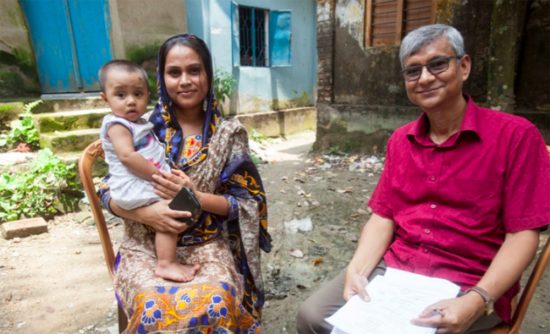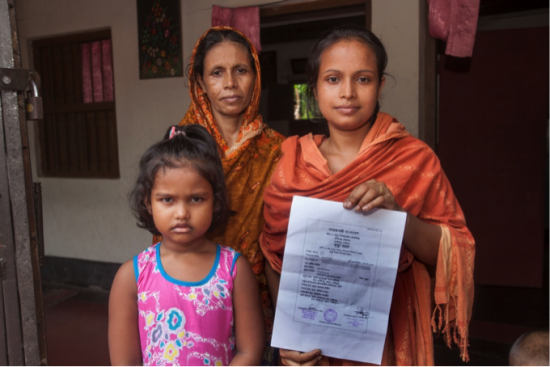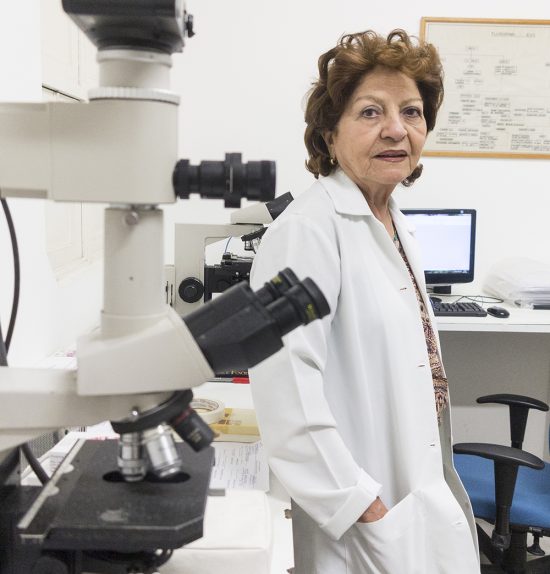By Dr. Philip Setel, Vice President and Director, Civil Registration/Vital Statistics Program at Vital Strategies.

Runa meets with a family planning assistant in Bangladesh to arrange a birth certificate for her daughter — which she did not have for herself growing up. It will give her daughter access to healthcare services and schooling.
Roughly 130 million babies are born every year. Nearly one-quarter of them will begin life without any official record of their existence.
The registration of a birth establishes one’s legal existence, providing access to rights benefits, entitlements and protections. The registration of deaths, marriages, and divorces is also of fundamental importance — particularly for women and children, who may need to establish proof of relationship to inherit property or pensions.
In many low- and middle-income countries, the Civil Registration and Vital Statistics (CRVS) systems that provide this function are facing major challenges. CRVS systems have the legal responsibility to register and record important life events like births, deaths (including cause of death), marriages and divorces. As World Health Day is celebrated around the world this April 7, those among the world’s poorest who lack the ability to prove their identity may be hindered in participating in social and economic benefits and protections afforded to others.

In Bangladesh, Bilkis’s husband died last year. She now realizes the importance of having a death certificate — to close his bank account and disperse assets to his heirs. “It also carries my husband’s legacy.”
An additional health-related benefit of well-functioning CRVS systems are the statistical data they produce, including about causes of death. This year, 65% of the deaths that will occur will not be registered with a cause. Even when a cause is registered, high proportions of ill-defined or catch-all causes like “senility” or “heart failure” limit the public health utility of the data.
Lack of such vital information generated from registration records prevents policymakers from using accurate data to develop and enforce policies and deliver services that will improve population health. Policy decisions are too often based on epidemiologic guesswork, and governments are prevented from addressing the true and most pressing public health problems at the national and sub-national level.

In Brazil, Dr. Ana Maria de Oliveira Ramos helps improve accuracy of death records to enhance health data. “When a death occurs, an interview is done to determine whether it was natural causes or not. Our primary role is to check people who died at home without medical assistance and hospital cases that do not yet have a defined cause.”
What’s more, investments in CRVS not only empower individuals and inform government, they play a critical role in contributing to and measuring progress toward the Sustainable Development Goals (SDGs); CRVS contributes to up to 40% of the SDGs and targets. Weak CRVS, therefore, hinder both the achievement and measurement of the SDGs. Of the nine health-related goals, five are directly measured by mortality measures that come from CRVS. Without accurate data, we cannot measure the real impact of interventions against the targets we’ve set — from maternal health and child mortality, to tuberculosis and HIV/AIDS, to the growing epidemic of noncommunicable diseases (NCDs) like cancer and diabetes.
There is, however, a growing body of experience — much of it gained through the Bloomberg Philanthropies Data for Health Initiative — that puts the lie to the common assumption among donors that CRVS systems are too broken, costly, and time-intensive to fix. Under this initiative, we’re working with governments in 20 low- and middle-countries around the world to improve the collection and use of critical public health data.
In places like Tanzania, for example, where only 8% of all deaths are assigned a cause of death (COD) that is of usable quality for vital statistics, programs are underway to improve the quantity and quality of COD data both in health facilities and — for the first time — from communities.
In Peru, we’re working with the Ministry of Health to scale up ‘SINADEF,’ a digital cause of death reporting and registration system for the country’s hospitals. Where implemented, SINADEF has nearly 100% completeness and has cut down the time it takes to produce reliable mortality data from 18 months to less than four weeks. In Bangladesh, we helped the government develop the ‘Kaliganj’ model CRVS system, which has resulted in a forty-fold increase in registration rates in areas where it has already been implemented.
Thanks to enhancements in technology, and modern approaches to business design and improvement, real progress is within reach. Country investments in improved CRVS systems are the best long-term way to sustainably determine the needs of national and sub-national populations. They are a double win for the billions of people currently being left behind, and for governments needing data for evidenced-based planning.
Dr. Philip Setel leads Vital Strategies’ Civil Registration and Vital Statistics work under the Bloomberg Data for Health Initiative, funded by Bloomberg Philanthropies and the Australian Government.